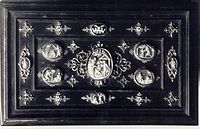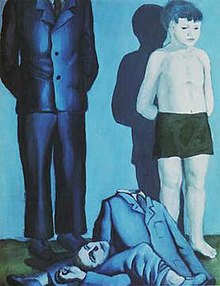This is an old revision of this page, as edited by Piotrus (talk | contribs) at 04:59, 24 January 2008 (→Destruction of Polish culture by the occupants: +image). The present address (URL) is a permanent link to this revision, which may differ significantly from the current revision.
Revision as of 04:59, 24 January 2008 by Piotrus (talk | contribs) (→Destruction of Polish culture by the occupants: +image)(diff) ← Previous revision | Latest revision (diff) | Newer revision → (diff)| An editor has nominated this article for deletion. You are welcome to participate in the deletion discussion, which will decide whether or not to retain it.Feel free to improve the article, but do not remove this notice before the discussion is closed. For more information, see the guide to deletion. Find sources: "Polish culture during World War II" – news · newspapers · books · scholar · JSTOR%5B%5BWikipedia%3AArticles+for+deletion%2FPolish+culture+during+World+War+II%5D%5DAFD |
| Part of a series on the |
| Culture of Poland |
|---|
 |
| History |
| People |
| Languages |
| Traditions |
| Mythology |
| Cuisine |
| Festivals |
| Religion |
| Art |
| Literature |
| Music and performing arts |
| Media |
| Sport |
| Monuments |
| Symbols |
Polish culture during World War II was brutally suppressed by the occupants. Both occupying powers - Nazi Germany and the Soviet Union - were hostile to the Polish culture and the Polish people, aiming at their destruction.
The last remaining Polish library - the Warsaw Public Library - was closed in 1941. The bookstores were emptied, with the last about a thousand Polish books (not previously proscribed) withdrawn in 1943. The only officially available reading was the press published by German occupation administration, with a ban on publication of Catholic dailies. Although the so-called Polish Press, published by the German authorities , featured religious articles for Catholics, these papers disseminated tendentious and falsified information on events in the Roman Catholic world, thus intentionally misleading public opinion. For instance, the leading article of the Kurier Czestochowski of January 5th, 1941, wrote on its front page with the headline "150 Million Catholics against England." Nevertheless, Polish authors were determined to continue writing while interweaving the past history and tradition with the living and suffering present. Polish culture was preserved by various underground institutions and groups. After the war the period of World War II has influenced a new generation of Polish artists.
Destruction of Polish culture by the occupants

Places of culture and science, like universities, schools, libraries, museums, theaters or cinemas, were either closed or changed to Nur für Deutsche. Many university professors, along with teachers, lawyers, artists, writers and other members of Polish intelligentsia were arrested, executed or sent to concentration camps (in operations such as German AB-Aktion operation in Poland); any formal publications of a Polish language book, literary study or a scholarly paper was nearly impossible. Many treasures of Polish culture were plundered and taken away to Germany; others were destroyed on purpose (see planned destruction of Warsaw).
To prevent the birth of a new generation of educated Poles, German officials decreed that Polish children's schooling end after a few years of elementary education. Heinrich Himmler wrote in a May 1940 memorandum, "The sole goal of this schooling is to teach them simple arithmetic, nothing above the number 500; writing one's name; and the doctrine that it is divine law to obey the Germans. . . . I do not think that reading is desirable".
Soviet authorities, particularly in the years 1939-1941, also attempted to remove the traces of Polish history of the area under their control by engaging in crash Sovietization and eliminating much of what had any connection to the Polish state or even Polish culture in general.
Underground Polish culture

Problems playing this file? See media help.

Nonetheless the Polish culture persisted, mostly through underground activities, like underground publications (bibuła), underground education or even underground theater.
During the Warsaw Uprising in summer 1944, in Polish-controlled territory, people tried to recreate the normal day-to-day life of their free country. Cultural life was vibrant, both among the soldiers and civilian population, with theatres, post offices, newspapers and similar activities. Headed by Antoni Bohdziewicz, the Bureau of Information and Propaganda of the Home Army had even created three newsreels and over 30,000 meters of film tape documenting the struggles.
Influence on Polish culture after the war
See also: Cultural representations of the Warsaw UprisingThe events of WWII had also significantly influenced a generation of Polish artists that became known as the Generation of Columbuses. This term denoties the entire generation of Poles born soon after Poland regained her independence in 1918, and whose adolescence has been marked by the tragic times of the World War II; in their art they "discover a new Poland" - one forever changed by the atrocities of WWII and following creation of a communist Poland.
Citations
- Olsak-Glass, Judith (January 1999). "Review of Piotrowski's Poland's Holocaust". Sarmatian Review. Retrieved 2008-01-24.
The prisons, ghettos, internment, transit, labor and extermination camps, roundups, mass deportations, public executions, mobile killing units, death marches, deprivation, hunger, disease, and exposure all testify to the 'inhuman policies of both Hitler and Stalin' and 'were clearly aimed at the total extermination of Polish citizens, both Jews and Christians. Both regimes endorsed a systematic program of genocide.'
- "The Nazi Kultur in Poland by several authors, with Foreword by John Masefield". London: Polish Ministry of Information. 1945. Retrieved 2008-01-23.
- ^ "World War II and The Communist Regime: Shakespeare in the Theatre of Political Allusions and Metaphors". Internet Shakespeare Editions. Retrieved 2008-01-24.
- ^ "Poles: Victims of the Nazi Era". United States Holocaust Memorial Museum. Retrieved 2008-01-24.
- Template:Pl icon Elżbieta Trela-Mazur (1997). Włodzimierz Bonusiak, Stanisław Jan Ciesielski, Zygmunt Mańkowski, Mikołaj Iwanow (ed.). Sowietyzacja oświaty w Małopolsce Wschodniej pod radziecką okupacją 1939-1941 (Sovietization of education in eastern Lesser Poland during the Soviet occupation 1939-1941). Kielce: Wyższa Szkoła Pedagogiczna im. Jana Kochanowskiego. p. 294. ISBN 978-83-7133-100-8.
{{cite book}}: Cite has empty unknown parameters:|chapterurl=and|coauthors=(help)CS1 maint: multiple names: editors list (link) - Template:Pl icon Nawrocka-Dońska, Barbara (1961). Powszedni dzień dramatu (1 ed.). Warsaw: Czytelnik. p. 169.
- Warsaw Uprising - Timeline